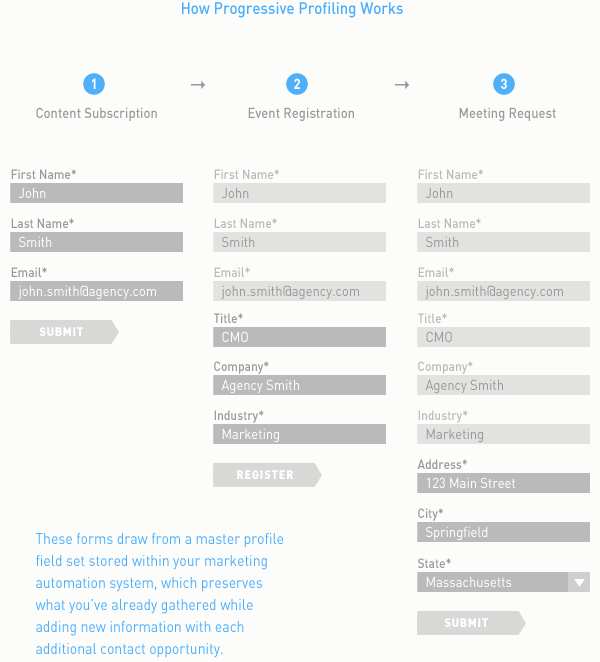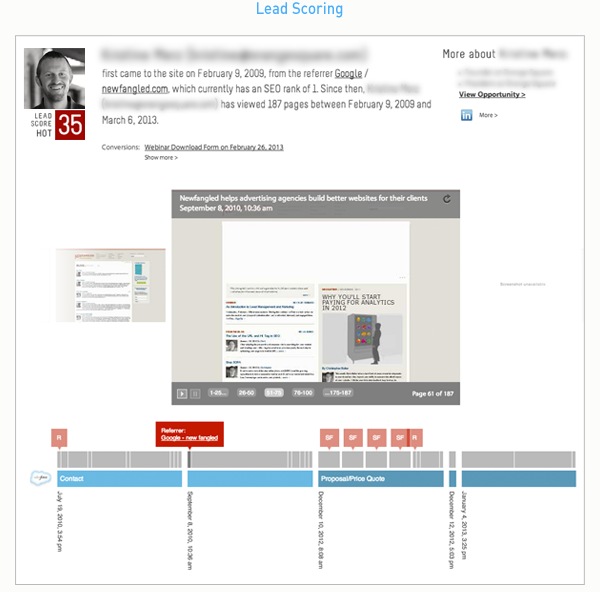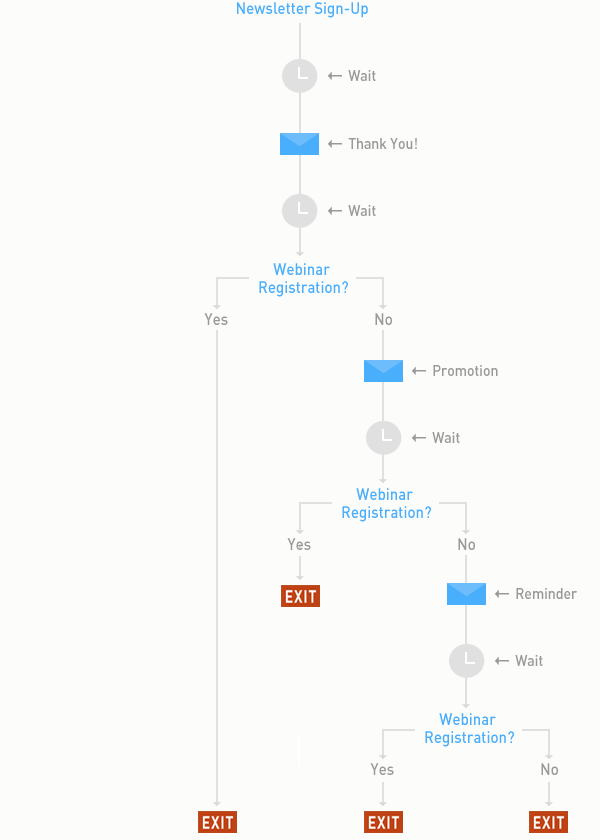Introduction
What happens when content marketing starts to work?
Not necessarily when you start feeling good about the content you’ve created — that you’re producing it at a steady clip, that you’re finding your voice, that it speaks faithfully to what you have to offer the marketplace — I mean actually working. Like, attracting the right sort of audience and converting them into qualified leads. And hopefully, a lot of them.
Successful content marketing will create a new problem for you to solve: one where your opportunity exceeds your capacity — not simply to deliver, but to even manage and nurture that opportunity before your sales process officially kicks in. Put simply, if your content marketing is working, you’re going to see an increasing volume of incoming leads. And if your lead volume increases, it’s going to start filling your customer relationship management (CRM) system with a whole lot more contacts. Potentially more than you can keep up with. At that point, how will you manage to properly score, sort, and nurture them?
After all, the majority of these new leads won’t be sales-ready. You already know that. If someone subscribes to your newsletter or registers for your next webinar, you don’t immediately send her a sales pitch. Instead, you say, “Great, she’s interested in what we have to say. Let’s let our content do its thing.” But then what? You can wait and hope that your content just happens to align with wherever your new subscriber may be in the sales cycle, or you can be more proactive. You can start looking more closely at her activity on your site (assuming your CMS has a micro-analytics component) and based upon that, make an assessment of her interest. Then, maybe you can start offering her more opportunities to engage with your content. Eventually, you might have cause to reach out to her directly, but that’s going to be a hands-free call with fingers crossed; you’re probably not going to know enough about her to make that call anywhere near warm. And all of this assumes you’ve got the manpower and time to do this with every new lead that comes in, which you probably don’t.
So you’re left with this problem: More names. Not enough time to sort through them all. A desire to sell to them. Not enough information to do that confidently.
Marketing automation is the solution.
What is Marketing Automation?
Marketo’s Definitive Guide to Marketing Automation defines marketing automation as a system that “streamlines, automates, and measures marketing tasks and workflows…so companies like yours can increase operational efficiency and grow revenue faster.” I like that definition because it focuses on outcomes — outcomes that everyone wants. But if that definition gets your attention, then you’re next question is, “How?”
Marketing automation enables you to achieve these outcomes by scoring, profiling, and prioritizing leads and then automating programs that nurture those leads based on buying stage. It’s far more data-reliant and rigorous than any system you might administer manually, and it leverages the efficiencies gained by automating marketing activities to increase actual sales while reducing cost per lead. Good for marketing. Good for sales.
Incidentally, the ideal relationship between marketing and sales can be expressed — at least in part — by the structural relationship between marketing automation and CRM. A CRM system, aside from being your central data repository, tells your sales story: who is looking at you, where they’re coming from, and what they’re telling you about themselves. Marketing automation tells your marketing story: what you’re telling your prospects and customers about you, as well as when and how.
Properly integrated — within your culture and with one another — CRM and marketing automation mean the end of marketing and sales silos. For marketing, it offers the power to cultivate deeper customer intimacy, more qualified prospects, and a reliable analytics core. For sales, it delivers a higher quality lead, far closer to sale than ever before. Overall — and this is for the CEOs reading this — this system makes an offer you can’t refuse. Executive summary: CRM + MA = Reduced Costs and Increased Revenue.
But What is Marketing Automation?
So marketing automation is a system. But marketing automation is also shorthand for software that assembles and consolidates the various parts of this system into a single tool. Though many tools are using marketing automation as a lure, true marketing automation software includes the following functionality: email, webinar, website integration, CRM integration, progressive profiling, lead scoring, drip nurturing, form building, page building, and A/B testing. Leave any one of those things off the list and you don’t have marketing automation.
And by the way, if you’re vetting marketing automation software, you need to be savvy about price, not just feature set. I overheard Mark O’Brien express this well just the other day when he said, “There are tons of people saying that they’re marketing automation, but we don’t know of any true marketing automation tools that cost less than $500 per month. Most actually cost $1,500 or more per month. Ours is $1,000 per month.” (Also, we’ve got a reseller program for our agency partners. If they work with us to build their site with marketing automation, we reduce their cost by $200 for every client they bring us that also does marketing automation. Only takes five before they’re getting it for free.) So.
If that gets your attention, you’re next question is, “Yeah, but how?”
In this article, I’m going to focus primarily on four specific functions of marketing automation: progressive profiling, lead scoring, lead segmenting, and automated programs — in that order, because each provides a foundation for the next — and how this sequence makes good on the big promises of marketing automation.
Progressive Profiling
The conversion is the currency of content marketing. But the conversion has flatlined. So-and-so comes to your site and, in exchange for a subscription to your newsletter, he gives you his name and email. Ok, great. Then so-and-so wants to subscribe to your blog digest. Access granted in exchange for name and email. A bit later, so-and-so wants to register for your next webinar. Maybe you stretch here and get his name, email, company, or even his title. Super. Then what? Well, if you’re really winning, so-and-so spends a lot of time on your site and learns a ton about what you do. Meanwhile, every page so-and-so lands on offers him things he’s already taken advantage of. Sign up! Register! Did that already. And that.
There’s a better way!
The whole point of collecting information is to collect it and learn from it. But there’s really only so much you can do with a name and email. What you really want is to know who this person is, and whether they’re a likely prospect. If they’re not, that’s fine and all. But you need to know that. And here’s the important part: finding out is perfectly OK, so long as your leads willingly hand you the information. The trick of it is doing so incrementally, because who in their right mind is going to give you their life story in exchange for your newsletter? So here’s how you do that:
First, you create a master profile. This contains all the things you need to know in order to properly vet a prospect. So, hypothetically: name, email, title, company, industry, location — perhaps even whether they’re looking to hire someone like you. This profile lives in both your CRM and marketing automation systems and remains in sync.
Next, you build smarter calls to action. When so-and-so first fills out a sign-up form, you get his name and email. That’s all you’re asking, and it’s also likely all he’ll be willing to share. I mean, c’mon. You_just_met. But you don’t just snag that data and dump it as a contact in your CRM. You do that, but you also store it in a cookie so you can keep track of what so-and-so is up to on your site. (This is for the greater good, so long as we don’t get big brothery about it.) But later, when so and so hits you up for a webinar registration, your site adds a few new fields to the form. So and so will see that you’ve remembered his name and email — which will probably elicit warm fuzzies before it elicits cold creepies — and you’ll ask him for his title, company name, and industry. This stuff updates his contact record in your CRM and gets stored in the cookie. Much, much later, when so and so decides to request a meeting with you, he sees you’ve remember everything he’s shared with you so far, and you get a bit more: location, comments, or any other means of vetting that makes sense to you. Make sense so far? A basic example is shown below:

The deal here is to progressively profile your prospects so that you can prioritize them later.
Oh, and bonus points for hiding calls to action that so-and-so doesn’t need to see again. Once he’s subscribed to your newsletter, focus on offering him something new. You generally want to keep your calls to action to three or fewer on a page; don’t waste a slot by repeating an offer that would be better filled by an opportunity to expand your contact’s profile. We call these smart CTAs.
Lead Scoring
Now that you’ve got a more expansive profile, you can begin to score your leads. High scoring leads are the ones you devote sales energy to, low scoring leads you leave alone. But what makes for a high score?
Well, that’s up to you, but here are some suggestions (note, these are arbitrary values):
- Qualification. You’re collecting session data, so pay attention to what content so-and-so consumes. +1 for key, positioning-oriented information and things like whitepapers, key newsletters, case studies, and the like; maybe +5 for reading your pricing page (assuming you have one). -1 for viewing your careers page.
- Seniority. You’ll collect so-and-so’s title at some point. What you want to know is whether so-and-so is a decision maker. +1 for decider status.
- Location. Does that matter to you? If so +1 for being in the right place. -1 for being in Delaware. (Just kidding. Go Blue Rocks?)
What makes this magical is that scoring is automated. You don’t sift through session data with a red pen. Instead, you assign content, events, and profile data values in your marketing automation system, and wait for it to alert you when so-and-so’s score is interesting.
Below is a real session as visualized by our CMS. I’ve redacted some info to protect so-and-so’s anonymity. Oh, and I swapped so and so’s face with Chris Creech’s just so you can see that the session view does that. Nifty, eh?

One thing to keep in mind is that the impact of repeat actions on lead score might be parabolic. So, the first couple of webinar downloads might accrue more points than additional ones, and then once it becomes clear that someone’s just going to school on your site, you might start docking points. It’s also worth noting that sometimes a super-session might indicate a prospect, and other times a competitor. Keep a close eye on it.
Lead Segmenting
Now that you’ve got more detailed and scored contacts, you can start segmenting them. Again, you’ll want to determine your segments based upon criteria unique to you, what you do, and your ideal client, but here are some suggestions:
- By Lead Score. After you’ve assigned values to content, events, and profile data, you can then create score tiers. That way, whatever alerts you get are more easily controllable and immediately meaningful. Cold/Warm/Hot works pretty well for this. So, contacts with lead scores of, say, 1-5 are cold. Contacts with lead scores of 5-15 are warm. And contacts with scores of 15 or more are hot. The hot ones merit an alert. And anyway, who doesn’t like receiving an email with “HOT” in the subject line?
- By Buying Stage. What behaviors indicate researchers vs. evaluators vs. purchasers? Sometimes lead score alone won’t indicate this, but aspects of so-and-so’s score will, like whether he viewed a particular research report, or completed a certain form. Isolating contacts by buying stage will enable you to more appropriately focus your marketing efforts on their needs.
- Or, tier them. Set up your buying cycle segments, and then sub-segment them by lead score. This way, you can isolate hot evaluators, from hot researchers (i.e. nice people who are going to school on your site).
By the way, ActOn has a great webinar on lead management that goes into segmentation in greater detail.
Automated Programs
Here’s the point of all this work. Once you’ve done all of this — progressively gathered richer contact profiles, scored them based upon their exposure to your content and their particular profile data, and then segmented, or prioritized, them — you can take action. This is where marketing automation gets fun.
Earlier, I introduced this whole marketing automation thing by pointing out just how difficult it would be to create and manage truly effective marketing campaigns for a high volume of contacts. But if you automate your programs, you only have to do the work of planning out their logic once. Then the system can manage them on its own. Just like the smart CTAs keep website users from seeing repetitive offers or information that is no longer relevant to them, an automated program schedules targeted and personalized messages to specific, segmented audiences rather than one-size-fits-all campaigns. These kinds of tailored programs are critical to nurturing your contact relationships proactively (not reactively), while retaining control over the flow of information.
How about an example?
So-and-so lands on your site and clicks around a bit. Right now, you know nothing about so-and-so. A bit later, so-and-so sees a call to action to subscribe to your newsletter. So-and-so signs up enthusiastically.
BOOM. So-and-so is now in the machine.
(Before you put this automated program into effect, you composed a few email messages within your marketing automation system. These are going to come in handy in just a moment.)
A couple of hours after signing-up, so-and-so gets an email from you. It basically says, “Hey, so-and-so, thanks for signing up for our newsletter. I think you’re really going to love it. Glad to have you aboard.” Or something like that. The idea is to make it personal. See, these aren’t anonymous, boilerplate marketing emails. These are emails from you. The only difference between these messages and ones you might compose right now, from your inbox, is that they’re composed elsewhere and queued to be sent at a time that makes the most sense for the recipient’s experience and your goals. So far so good. So-and-so feels happy.
A couple of weeks later, your marketing automation system checks to see if so-and-so is registered for your next webinar. He isn’t, so the system fires off one of those other emails you prepared. Basically: “Hey, so-and-so! Hope you’ve been enjoying the newsletter. Did you know we’ve got a webinar coming up on that thing you’re interested in? You should register for it.” So-and-so considers this.
A week before your next webinar, the system checks again to see if so-and-so registered. He didn’t. So, the system fires off one last reminder — another email from you. At this point, so-and-so is removed from this program no matter what. If he didn’t register, he remains on your newsletter subscriber list. If he did, he’s on both your newsletter subscriber list and your webinar list.
Need to see it to believe it? Here’s how the automated program logic looks:

The beauty of automated programs is that they can be constructed for just about anything. Import an attendees list from your recent event? Create a program that thanks them, offers them subscription or event registration opportunities, checks to see if they took advantage of them, reminds them, then files them away appropriately. You could even use an automated program to follow up with clients after an engagement, or to survey employees. It’s that flexible, and boy does it save you a ton of time!
Parting Thoughts
The value of this system is pretty obvious, I think. But it’s also valued relative to your need, which I began by pointing out is a function of how well your content marketing initiatives are working. So, if you’re still struggling to gain traction with your content, marketing automation won’t fix that.
But, there are ways to accelerate things. Building a list organically will take years — there’s really no way around that. But last month, Mark mentioned some of the benefits of buying a contact list as a means of getting to a healthy subscriber number faster than, say, twelve years. The interesting thing is that these new practices are beginning to blur the line between inbound and outbound marketing, perhaps bringing things back to a more balanced place. Content marketing has typically been about inbound, but as we’ve heard time and again from our partners, organically building interest through content alone is a very, very slow process. Until recently, configuring and purchasing a well-curated list (so well-curated, I might add, that very few recipients will unsubscribe after receiving their first message from you) was too difficult and too expensive. That’s changed, and is absolutely worth experimenting with. If you’re interested in that, I’d recommend attending our webinar on Contacts & Content, which will feature Dave Currie, CMO of The List.
